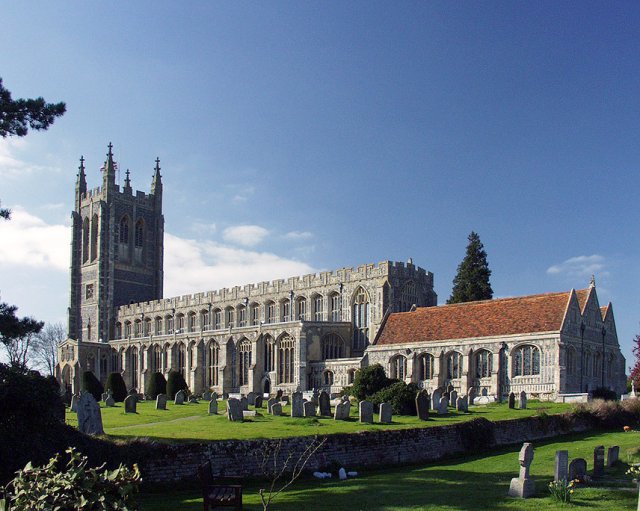- Regular Price
- £19.99
- Sale Price
- £19.99
- Regular Price
- £19.99
- Unit Price
- per

My imagination ran wild when I first read about wool churches. Cashmere pews, a mohair altar, and steeples made of merino wool. Completely impractical – yes – but a warm place to go and sooth the soul as the nights grow colder.
In reality, a wool church isn’t as cosy (or impractical) as it sounds. You may live close to one and not even know it and they actually look little different from any other English church. However, they are a fascinating piece of our history – standing as monuments to the importance of the medieval wool trade.
The backbone of the economy in medieval England (between 1250-1525), the wool trade was the chief industry of the nation. At its height, around 45,000 sacks of wool, produced by 10 million sheep, were exported every year. This trade provided over 60% of the Crown’s total annual income during the reign of Henry V.
The Cotswolds (meaning ‘hills of the sheep cottes’, a ‘cot’ being a sheep enclosure) and parts of East Anglia thrived as centres of wool commerce. The affluence of these towns was quite remarkable; in the fifteenth century, the medieval wool town of Lavenham (pop. 2,000) alone paid more tax than York or Lincoln (pop. 7,000 & 6,000). Those 10 million sheep shared the English countryside with a human population of less than 3 million - around 4 sheep per person, compare that to the 14 million sheep in England today with our population of over 57 million people, an almost exact reversal of the ratio.
So, why did these wealthy woolmen spend colossal sums of money constructing or embellishing churches? The obvious answer is that it demonstrated their wealth and power to people, both near and far. Being larger and far more ornate than an average town church, wool churches often looked overbearing and out of place in the otherwise quaint communities. The benefactor wanted to ensure the whole community knew who had paid for this extravagant project.
Being born a few hundred years before sports cars and foreign holidays (the Crusades having gone out of fashion in the 13th Century), the most prosperous wool magnates laid out their lucre on the next best thing: churches, perhaps the medieval equivalent of a mission to Mars.
Even today, inside many Cotswold churches, you can still find a woolman’s brass in the pavement – they are often depicted to be standing on a sheep or woolpack. The purpose was to memorialise their own charity - the virtue-signalling medieval forerunner of boasting on social media about one’s philanthropy.

A memorial brass of wool merchant John Fortey (1458) showing sheep at his feet, in the parish church of St Peter & St Paul, Cotswolds
Of course, there were other reasons. The very visible charitable acts to the Church were also a sure-fire way to guarantee a spot in Heaven and doubtless incentivised wool magnates to dig deep into their pockets. It was also common for religious orders to own flocks of sheep, who would ‘encourage’ merchants to give portions of their profit to the Church, in return for their trade, helping the Church use modern trade to and keep its coffers filled and maintain its grip on power.

Building or enhancing a church was a gargantuan expense – even for the ludicrously rich woolmen. They would therefore often club together to pay for the work. John Fortey’s (image above) donation of £300 in 1458 - almost £200,000 today - to the church of St Peter & St Paul only covered the nave and clerestory windows! However, there were some exceptionally wealthy magnates, like John Clopton (all woolmen were supposedly called John), who paid almost entirely for the restoration and expansion of the Holy Trinity Church in Long Melford between 1467 and 1497 (image below).
From 1525, the wool trade declined, ending the construction of wool churches. 500 years later, however, the vast majority still stand as crucial reminders of the largely forgotten importance of the medieval wool trade.
Further Reading:
https://www.britainexpress.com/cotswolds/wool-churches.htm
https://historyofengland.typepad.com/files/the-wool-trade-by-eileen-powers.pdf
https://www.greatenglishchurches.co.uk/html/long_melford.html
https://www.thefield.co.uk/country-house/wool-churches-built-golden-fleeces-43370
Image credits:
Holy Trinity Church Long Melford: https://commons.wikimedia.org/wiki/File:Long_Melford_-_geograph.org.uk_-_4048.jpg https://creativecommons.org/licenses/by-sa/2.0/
4 comments
Sorry another question. Do you have seat pads (rather than cushions). About 35 × 35 cm and 5cm thick. I’m making cushions from old velvet curtains for my hard wooden chairs.
A very Interesting read.
This is absolutely fascinating. I had no idea wool had been so lucrative, nor that the proceeds had been used to lavish on churches or philanthropic virtue signalling. I love your blogs. They’re always so informative and original.
Really informative piece of Church history…thank you